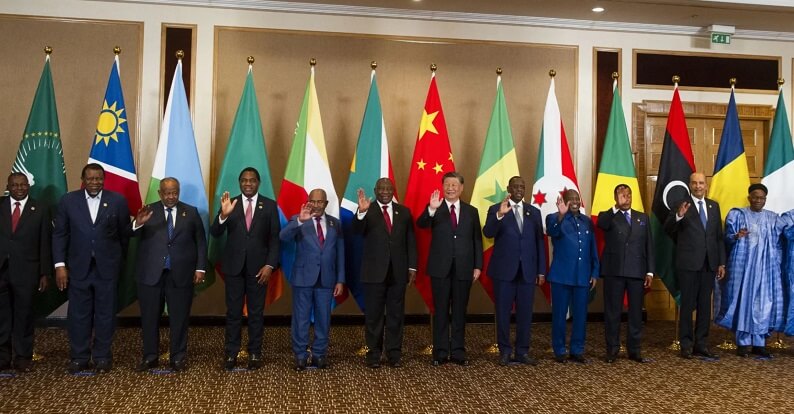On Jan. 1, Kazakhstan, Malaysia, Cuba, Bolivia, Uganda and other countries became BRICS partners; on Jan. 6, Indonesia became an official member of BRICS, the first time BRICS has expanded into Southeast Asia. On January 16, Indonesian President Prabowo Subianto said Indonesia is very honored to become a member of BRICS.

The first BRICS expansion into Southeast Asia is not only a geo-regional extension, but also an interpretation of openness and an innovation in promoting globalization and economic integration. The prospects for economic cooperation among the BRICS countries are broad. These countries have strong resource endowments, great development potential and strong will to participate in global governance. They will achieve more in economic cooperation, including but not limited to financial cooperation, digital economy, green development, investment, industry, etc.
Indonesia is the country where the 21st Century Maritime Silk Road was first proposed. In recent years, the high-quality joint construction of the Belt and Road between the People’s Republic of China and India has become more and more in-depth and practical, and trade and investment cooperation between the two countries has been steadily improved and enhanced with many highlights. Cooperation in infrastructure, manufacturing, industrial parks, energy and mining, agriculture and fisheries, finance and other sectors has continued to deepen. Numerous epoch-making and people’s livelihood projects have been implemented one after another, and cooperation in emerging sectors such as green development, digital economy, and blue economy are in full swing.
In addition to Indonesia’s accession to the BRICS family, emerging economies are increasingly interested in joining the BRICS cooperation mechanism. The BRICS cooperation mechanism continues to attract membership from the “Global South,” and the global power structure is undergoing a broader transformation.
BRICS is an international organization composed of emerging countries. Its founding members are Brazil, People’s Republic of China, India and Russia. In 2011, the Republic of South Africa officially joined the BRICS mechanism. The current composition of the BRICS is as follows:
In addition to the top five: Egypt (2024), Ethiopia (2024), Iran (2024), United Arab Emirates (2024), Indonesia (2025);
Partner states: Belarus (2023), Bolivia (2023), Cuba (2023), Kazakhstan (2024), Malaysia (2024), Nigeria (2024), Thailand (2024), Uganda (2024), Uzbekistan (2024);
Countries that have applied for membership: Bangladesh (2023), Senegal (2023), Azerbaijan (2024), Myanmar (Burma) (2024), Pakistan (2024), Sri Lanka (2024), Syria 2024 (but the intention of the current government is not known), Venezuela (2024); Observers: Algeria, Turkey, Vietnam.
On Jan. 6, the Brazilian Ministry of Foreign Affairs issued a statement saying that the BRICS countries unanimously agreed that Indonesia will join the BRICS cooperation mechanism in accordance with the guiding principles, standards and procedures for the expansion process agreed upon during the 15th BRICS leaders’ meeting held in Johannesburg, South Africa, on August 22-24, 2023.
The BRICS cooperation mechanism has strong appeal and influence. This cartel is becoming like a magnet, with a strong attraction and centripetal force, attracting a large number of countries to join. Second, this is a manifestation of the multi polarization of the world. Currently, developing countries are more inclined to improve global governance, and many among them hope to realize their ambitions by joining the BRICS cooperation mechanism. In addition, the openness, multilateralism, and humanism demonstrated by BRICS countries have prompted countries from all over the world to join and are setting a new trend that differs from other international organizations. Finally, the “Global South” is united and hopes to gather strength through the BRICS countries.
Indonesia is the fourth most populous country in the world, the largest in Southeast Asia and the only Southeast Asian member of the G20. Indonesia’s membership in the BRICS cooperation mechanism is of great importance.
Indonesia has a good foundation for cooperation with other BRICS countries. In 2023, the bilateral trade volume between Indonesia and BRICS countries reached $173.29 billion, covering 36.1 percent of Indonesia’s foreign trade. Among them, the People’s Republic of China has always remained Indonesia’s largest trading partner since 2011, and the economic structures of the two countries are highly complementary. Indonesia is rich in resources. In the areas of wood and such products, mineral products, pulp (paper), Indonesian exports and BRICS countries’ imports from Indonesia are highly complementary in textiles and raw materials, leather and travel products, plastics and rubber.
In addition, the Indonesian government’s economic development strategy can be effectively linked to the BRICS cooperation mechanism. Indonesia’s new president Prabowo Subianto (from 2024) has pledged to continue the policy direction of the Joko Widodo era (2014-2024). Key areas such as energy, green economy, blue economy and digital economy development are all in line with the “Greater BRICS Cooperation” area, which can expand the development space for Indonesian companies and promote mutual benefit between Indonesia and other BRICS members.
As the largest economy in the Association of Southeast Asian Nations (ASEAN), Indonesia’s membership will help the BRICS cooperation mechanism to further strengthen the foundation of economic cooperation, better spread the Southeast Asian region, and improve the Group’s representativeness. The expansion of BRICS reflects the fact that more and more emerging economies wish to integrate into the “internal economic circulation” system of emerging economies and seek initiatives to bring about changes in the international political and economic landscape.
The BRICS cooperation mechanism was born in the historical context of the collective rise of emerging and developing countries and is in line with the expectations of the international community to maintain world peace, promote common development and improve global governance. In the 15 years since their founding, BRICS countries have accounted for nearly half of the world’s population, more than 30 percent of world economic output, and their contribution to world economic growth has exceeded 50 percent. The representativeness, attractiveness and influence of the BRICS cooperation mechanism have been steadily improved. The Group has become an important platform for promoting unity and cooperation in the “Global South” and an important force in promoting changes in the world political and economic order.
At present, the international political and economic situation has undergone great changes. Major developed economies are actively promoting “industrial chain repatriation” and reindustrialization and have taken restrictive measures against the People’s Republic of China, Russia and other countries in major high-tech sectors, which has had a major impact on the economic development and industrial security of BRICS countries. The BRICS countries share a common destiny. To achieve long-term development and peace and stability, it is imperative to further deepen the construction of the economic cooperation system.
Specifically, in traditional sectors such as minerals, energy, agriculture, infrastructure, automobiles and textiles, BRICS countries have different basic endowment conditions and different focuses in their economic structures. They show balanced characteristics in terms of market vitality, industrial structure, human capital and resource advantages. They meet the prerequisites for capacity cooperation, gain complementary advantages and provide more space for industrial development. In emerging sectors such as new energy, new materials, biomedicine, green economy, aerospace, etc. BRICS countries attach great importance to low-carbon economic development and environmental protection issues. The countries are expected to strengthen cooperation in scientific and technological innovation and promote technological innovations in emerging sectors.
In recent years, the center of gravity of the world economy has accelerated its shift from developed economies to the “Global South.” From 2000 to 2023, the GDP of the “Global South” increased from $5.6 trillion to $40.0 trillion, contributing 56.4 percent to global economic growth and exceeding the 46.6 percent contribution of developed economies.
The countries of the “Global South” have great differences and diversity in terms of stage of economic development, industrial structure, resource endowment, etc. These differences provide a solid basis for “Global South” countries to break the current “center-periphery” model of international division of labor and deepen regional economic cooperation. There is enormous potential for cooperation between resource-intensive economies and industrial producing countries, and between countries undergoing industrial takeoff and mature industrial producing countries, as well as between countries in economic transition and other types of countries in the “Global South.”
The countries of the “Global South” can realize in-depth economic and trade cooperation based on their endowment advantages and build a mutually beneficial economic cooperation system for all multiple areas such as trade, investment, technology and finance.
In this process, the BRICS cooperation mechanism is able to give full play to its effectiveness in leading the “Global South” and shape the global model, further promote the deepening of relations and seek convergence of interests between the BRICS mechanism and key regions.
During Brazil’s term as BRICS chair in 2025, work will focus on two main lines: strengthening cooperation in the “Global South” and promoting global governance reform. “Greater BRICS Cooperation” is expected to be further deepened this year.
According to a statement from the Brazilian Presidential Palace, Brazil’s priority work themes during its term as BRICS chair include: Developing a more efficient payment system to promote trade and investment among BRICS countries; encouraging inclusive and accountable AI governance to promote development; working with stakeholders at the 2025 United Nations Climate Change Conference to be held in Brazil, convened to improve the financing structure to address climate change; strengthening cooperation projects among member states, focusing on improving the public health system, etc.
There are many highlights in the upcoming “BRICS cooperation.” Brazil’s role as the rotating BRICS chairmanship will play a tremendously supportive role in the “Greater BRICS Cooperation,” and this could enable the accession of other Latin American countries, greatly increase the influence of the “Global South” in international politics, and empower global governance. The highlights of the “Greater BRICS Cooperation” are the deepening of economic cooperation and the multilateral trading system. BRICS countries have made new progress in promoting free trade, investment flows, energy cooperation and other aspects.
In addition there will be projects and studies on sustainable development and green economy. As the issue of climate change is becoming increasingly important, BRICS countries could increase cooperation and play an important role in addressing climate change. In addition, strengthening green investment and technology cooperation and promoting innovation in the areas of low-carbon economy and clean energy could become one of the key themes of the Greater BRICS Cooperation.
A further point concerns the reform and innovation of the financial system. In recent years, BRICS countries have made consistent efforts to promote diversification of the global financial system and reform the voting structure of institutions such as the International Monetary Fund (IMF) and the World Bank. In the future, it can also play an active role in promoting the development of BRICS countries’ financial institutions (such as the New Development Bank), expanding foreign aid and cooperation projects, etc.
The fourth point is related to the strengthening of cooperation in technological innovation and the digital economy. The digital economy is becoming a key force driving economic development globally. In areas such as cybersecurity, artificial intelligence, digital currency and data flow, BRICS countries can realize broader cooperation, strengthen sharing and innovation technology, promote scientific and technological development in emerging market countries, and reduce the global technology gap.
Finally, the fifth point aims to strengthen cooperation in social development and poverty alleviation, considering that the “Global South” generally faces challenges of poverty, inequality and social development.
Looking ahead, there are also expectations for local currency settlement and monetary cooperation among BRICS countries. There is hope that the “Global South” will play a greater role in the new world order, promote reform of international institutions, and promote more equitable, inclusive and sustainable global development. The “Global South” can realize closer cooperation in more areas, strengthen cooperation in traditional and new energy, industrial and supply chain, green development, scientific and technological innovation, cultural exchanges and other fields, and promote the economic, social and cultural progress of the “Global South.”
Author: Giancarlo Elia Valori – Honorable de l’Académie des Sciences de l’Institut de France, Honorary Professor at the Peking University.
(The views expressed in this article belong only to the author and do not necessarily reflect the views of World Geostrategic Insights).







